小学英语介词用法大全 (1)
小学英语介词短语(好)
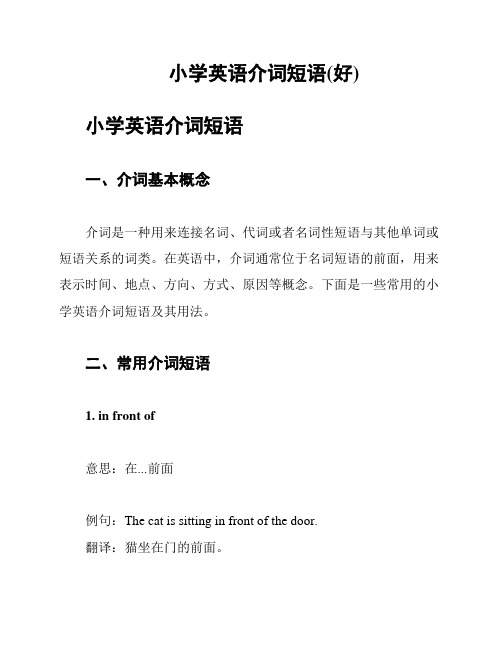
小学英语介词短语(好)小学英语介词短语一、介词基本概念介词是一种用来连接名词、代词或者名词性短语与其他单词或短语关系的词类。
在英语中,介词通常位于名词短语的前面,用来表示时间、地点、方向、方式、原因等概念。
下面是一些常用的小学英语介词短语及其用法。
二、常用介词短语1. in front of意思:在...前面例句:The cat is sitting in front of the door.翻译:猫坐在门的前面。
2. at school意思:在学校例句:I study English at school.翻译:我在学校学英语。
3. on the table意思:在桌子上例句:The book is on the table.翻译:书在桌子上。
4. under the tree意思:在树下例句:We had a picnic under the tree. 翻译:我们在树下野餐。
5. with a friend意思:和朋友在一起例句:I like playing soccer with a friend. 翻译:我喜欢和朋友一起踢足球。
6. by the beach意思:在海滩旁边例句:They built sandcastles by the beach. 翻译:他们在海滩旁边堆沙堡。
7. for breakfast意思:作为早餐例句:I had cereal for breakfast.翻译:我吃了谷物当早餐。
8. after school意思:放学后例句:Let's go to the park after school. 翻译:放学后我们去公园。
9. in the morning意思:在早晨例句:I like to jog in the morning.翻译:我喜欢早晨慢跑。
10. with a smile意思:带着微笑例句:She always greets everyone with a smile.翻译:她总是带着微笑向每个人打招呼。
小学英语语法-介词

小学英语语法-介词介词的定义介词是一种表示名词或代词与其他词之间关系的词类。
它可以表示时间、地点、方式、原因等关系。
常见的介词以下是小学英语中常见的介词及其用法:in:表示在某个地点或某个范围内。
例如:in the park(在公园里)、in the morning(在早上)。
in:表示在某个地点或某个范围内。
例如:in the park(在公园里)、in the morning(在早上)。
in:表示在某个地点或某个范围内。
例如:in the park(在公园里)、in the morning(在早上)。
on:表示在某个表面或某个特定日期。
例如:on the desk(在桌子上)、___(在星期一)。
on:表示在某个表面或某个特定日期。
例如:on the desk(在桌子上)、___(在星期一)。
on:表示在某个表面或某个特定日期。
例如:on the desk(在桌子上)、___(在星期一)。
at:表示在具体的时间或某个地点。
例如:at 7 o'clock(在7点)、___(在学校)。
at:表示在具体的时间或某个地点。
例如:at 7 o'clock(在7点)、___(在学校)。
at:表示在具体的时间或某个地点。
例如:at 7 o'clock(在7点)、___(在学校)。
to:表示向某个地点或某个目标。
例如:go to the supermarket (去超市)。
to:表示向某个地点或某个目标。
例如:go to the supermarket(去超市)。
to:表示向某个地点或某个目标。
例如:go to the supermarket(去超市)。
from:表示从某个地点或某个时间开始。
例如:___(从星期一到星期五)。
from:表示从某个地点或某个时间开始。
例如:___(从星期一到星期五)。
from:表示从某个地点或某个时间开始。
例如:___(从星期一到星期五)。
by:表示通过某种方式或某个工具。
小学英语:介词顺口溜 (1)
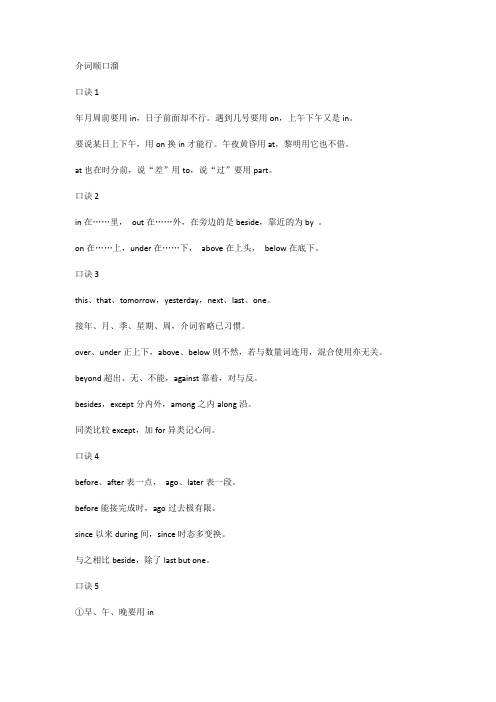
介词顺口溜口诀1年月周前要用in,日子前面却不行。
遇到几号要用on,上午下午又是in。
要说某日上下午,用on换in才能行。
午夜黄昏用at,黎明用它也不借。
at也在时分前,说“差”用to,说“过”要用part。
口诀2in在……里,out在……外,在旁边的是beside,靠近的为by 。
on在……上,under在……下,above在上头,below在底下。
口诀3this、that、tomorrow,yesterday,next、last、one。
接年、月、季、星期、周,介词省略已习惯。
over、under正上下,above、below则不然,若与数量词连用,混合使用亦无关。
beyond超出、无、不能,against靠着,对与反。
besides,except分内外,among之内along沿。
同类比较except,加for异类记心间。
口诀4before、after表一点,ago、later表一段。
before能接完成时,ago过去极有限。
since以来during间,since时态多变换。
与之相比beside,除了last but one。
口诀5①早、午、晚要用inin the morning 在早上in the afternoon 在下午in the evening在晚上in the day 在白天②黎明、午、夜、点与分用atat night 在夜间six o‘clock 在6点钟at 7:30 在7点半at nine fif** 在9点15分at the weekend 在周末③年、月、年月、季节、周用in。
例;in 1986 在1986年in 1927 在1927年in april 在四月in march 在三月in december 1986 1986年12月in july l983 1983年7月in spring 在春季in summer 在夏季in autumn 在秋季in winter 在冬季in the fist week of this semester 这学期的第一周in the third week 在第三周④阳光、灯、影、衣、冒雨用in,在阳光下,在灯下,在树阴下,穿衣、着装、冒雨等都要用in。
小学英语介词和副词用法大全
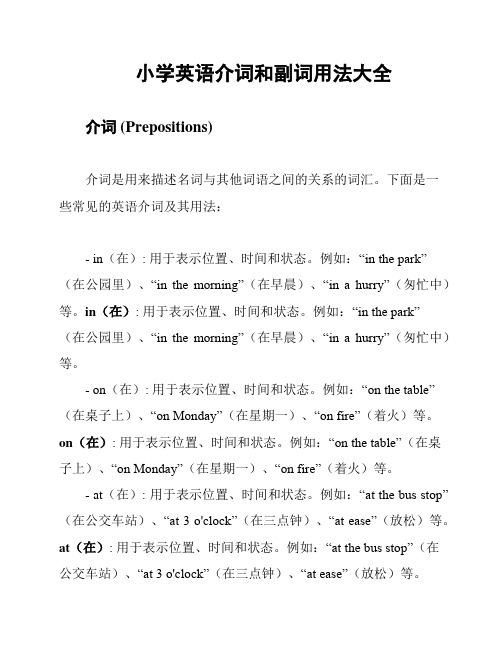
小学英语介词和副词用法大全介词 (Prepositions)介词是用来描述名词与其他词语之间的关系的词汇。
下面是一些常见的英语介词及其用法:- in(在): 用于表示位置、时间和状态。
例如:“in the park”(在公园里)、“in the morning”(在早晨)、“in a hurry”(匆忙中)等。
in(在): 用于表示位置、时间和状态。
例如:“in the park”(在公园里)、“in the morning”(在早晨)、“in a hurry”(匆忙中)等。
- on(在): 用于表示位置、时间和状态。
例如:“on the table”(在桌子上)、“on Monday”(在星期一)、“on fire”(着火)等。
on(在): 用于表示位置、时间和状态。
例如:“on the table”(在桌子上)、“on Monday”(在星期一)、“on fire”(着火)等。
- at(在): 用于表示位置、时间和状态。
例如:“at the bus stop”(在公交车站)、“at 3 o'clock”(在三点钟)、“at ease”(放松)等。
at(在): 用于表示位置、时间和状态。
例如:“at the bus stop”(在公交车站)、“at 3 o'clock”(在三点钟)、“at ease”(放松)等。
- over(在...之上): 用于表示在某物体的上方。
例如:“overthe bridge”(过桥)、“the plane flew over the city”(飞机飞过城市)等。
over(在...之上): 用于表示在某物体的上方。
例如:“over the bridge”(过桥)、“the plane flew over the city”(飞机飞过城市)等。
- under(在...之下): 用于表示在某物体的下方。
例如:“under the table”(在桌子下面)、“the cat hid under the bed”(猫躲在床底下)等。
关于小学介词英语语法大全

关于小学介词英语语法大全以下是给大家整理的关于小学介词英语语法大全,希望可以帮到大家介词又叫前置词,是一种用来表示词与词、词与句之间关系的词,它一般放在名词、代词(宾格)或动词(动词ing形式)前面。
1、in①在里面。
如:in the classroom②in+颜色,穿着颜色的衣服。
如:Whos the man in white?③in+语言,用某种语言说。
如:Whats this in English?④在上午、下午、晚上。
如:in the morning,in the afternoon,in the evening⑤在年、月、季节前。
如:in 2008,in August,in summer⑥在国家、城市和较大的地方前。
如:in China,in Wuxi,in the playground⑦固定搭配。
如:in the middle of(在中间),do well in(擅长),in the day(在白天),take part in(参加),stay in bed(躺在床上),in the street(在街上)2、on①在上面。
如:on the desk②用在某一天(上、下午)前。
如:on the 5th of May,on Sunday,on Monday morning③以Day结尾的节日前。
如:on Childrens Day,on New Years Day④固定搭配。
如:on foot(步行),on duty(值日),put on(穿上),get on(上车) turn on(打开),on the right / left(在右边/左边),on the wall (在墙上),on Zhongshan Road(在中山路上)注意:树上长的水果用on the tree;不是树上长的外来物用in the tree。
如:I can see a lot of apples on the tree. There is a boy in the tree.3、at①在某个时刻前。
小学英语常用介词用法

小学英语常用介词2)after(在……之后):after breakfast 早饭后,after school 放学后,after class 课后3)before(在……之前):before class 课前,before lunch 午饭前4)at(在):at home在家,at school 在学校,at work 在工作。
5)in(在……里面;用;戴):in English 用英语,in a hat 戴帽子,in front of 在……前面,in line 排成一行,in the end 最后,in the open air 在野外,in a minute立刻,in surprise 惊奇地,in time及时,in trouble 处在困难中。
6)on(在、关于):on one’s way home 回家路上,on duty 值日,on foot 步行,on top of 在……上面。
on the earth 在地球上。
7)under(在……下面):under the desk 在书桌下,under the tree 在树下8)between(在两者之间):between the two children 在两个孩子之间,between A and B 在A 和B之间。
9)beside(在……旁边):sit beside her 坐在她身边,beside the river 在河边。
10)behind(在……后面):behind the house 在房子后面,behind the door 在门后。
11)near(在……附近):near the river 在河边,stand near the door 站在门旁。
12)into(在……里):come into the classroom 进入教室,fall into the water 掉进水里13)outside (在……之外):outside of gate 在大门外。
小学英语介词的用法总结

介词的用法1 .表示地点位置的介词1)at ,in, on, to, forat⑴表示在小地方;(2)表示“在……附近,旁边”in⑴表示在大地方;(2)表示“在.一范围之内”。
on表示毗邻,接壤,“在……上面”。
to表示在……范围外,不强调是否接壤;或“到……”2)above, over, on 在……上above指在……上方,不强调是否垂直,与below相对;over指垂直的上方,与under相对,但over与物体有一定的空间,不直接接触。
on表示某物体上面并与之接触。
The bird is flying above my head. There is a bridge over the river.He put his watch on the desk.3)below, under 在... 下面under表示在…正下方below表示在……下,不一定在正下方There is a cat under the table.Please write your name below the line.4)in front [frant]of, in the front of 在..... 前面in front of…意思是“在……前面”,指甲物在乙物之前,两者互不包括;其反义词是behind (在.. 的后面)。
There are some flowers in front of the house.(房子前面有些花卉。
)in the front of意思是"在…..的前部”,即甲物在乙物的内部.反义词是at the back of…(在……范围内的后部)。
There is a blackboard in the front of our classroom.我们的教室前边有一块黑板。
Our teacher stands in the front of the classroom.我们的老师站在教室前.(老师在教室里)5)beside,behindbeside表示在... 旁边behind表示在... 后面2 .表示时间的介词1)in , on,at 在... 时in表示较长时间,如世纪、朝代、时代、年、季节、月及一般(非特指)的早、中、晚等。
小学英语介词总结
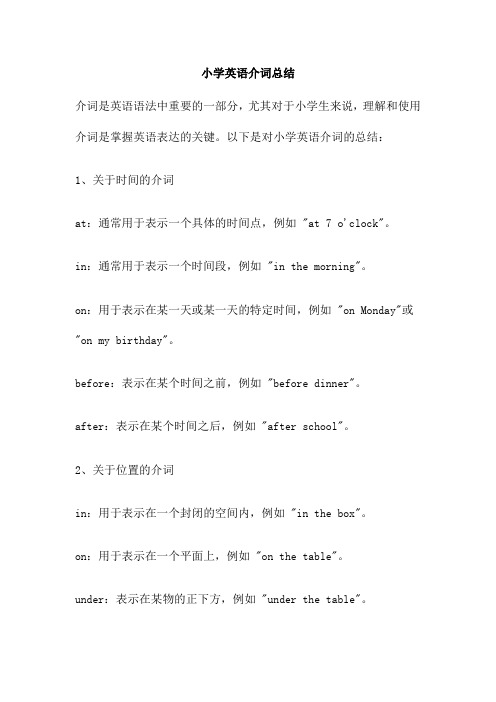
小学英语介词总结介词是英语语法中重要的一部分,尤其对于小学生来说,理解和使用介词是掌握英语表达的关键。
以下是对小学英语介词的总结:1、关于时间的介词at:通常用于表示一个具体的时间点,例如 "at 7 o'clock"。
in:通常用于表示一个时间段,例如 "in the morning"。
on:用于表示在某一天或某一天的特定时间,例如 "on Monday"或"on my birthday"。
before:表示在某个时间之前,例如 "before dinner"。
after:表示在某个时间之后,例如 "after school"。
2、关于位置的介词in:用于表示在一个封闭的空间内,例如 "in the box"。
on:用于表示在一个平面上,例如 "on the table"。
under:表示在某物的正下方,例如 "under the table"。
above:表示在某物的上方,但是不一定是正上方,例如 "above the table"。
beside:表示在某物的旁边,例如 "beside the book"。
3、关于方向的介词to:用于表示朝向某个方向或地点,例如 "go to school"。
from:用于表示从一个地方或位置到另一个地方或位置,例如 "come from school"。
towards:表示朝向某个方向或地点,但是不一定到达那里,例如"walk towards the park"。
4、关于原因的介词because:用于表示原因或理由,例如 "I am late because I missed the bus"。
小学英语常用介词及用法

小学英语常用介词及用法常见介词及用法(一)表示时间的介词1.英语里最常见的时间介词有:at, in, on, before, after和from。
2.at , in和XXX这三个词都表示时间。
at主要指具体的钟点:at half past eight在八点半XXX一般指某一段时间:in XXX在一月份on指具体在某一天:on XXX在星期一3.before和XXX表示时间的先后顺序。
XXX表示“在……之前”。
XXX.吃饭前你应该洗手。
XXX表示“在……之后”。
They often play basketball after XXX.他们放学后经常打篮球。
4.from作时间介词含有“从……开始”的意思,常和to连用,组成“from…to…”的结构,透露表现“从……到……”的意义。
We go to school from Monday to Friday.我们从周一到周五上学。
(二)表示方位的介词,也就是表示位置和地点的介词。
1.小学阶段常见的方位介词有:on, in, at, under, over, above, below, about,around, between等。
2.on, over和above这三个词都有“在……上面”的意思,但它们所表示的方位还是有些不同。
on表示两个物体的表面相互接触。
如:There is a book on the desk.桌上有一本书。
The boy is XXX那个孩子睡在地上。
over透露表现“在……的正上方”,两个物体表面没有打仗。
如:There is a light bulb over my head.在我头顶上有一个灯泡。
above透露表现两个物体中一个在另外一个的上方,如:XXX.飞机上云层上飞行。
1There are four lights above our head.在我们头上有四盏灯。
3.under和below都有“在……的下面”的意思,但它们有区别:under表示“在……的正下方”,其反义词是over。
小学英语常用介词用法

小学英语常用介词用法在学习英语的过程中,掌握介词的正确用法是非常重要的。
介词是连接词与词之间关系的一种词类,它能够表示时间、地点、方式、原因等等。
在小学英语中,常用的介词有很多,下面将为大家介绍一些常用的介词及其用法。
1. in介词"in"用于表示在某个范围内或在某个具体的位置上。
例如:- I live in a house.- There is a book in the bag.2. on介词"on"用于表示在某个表面上。
例如:- The cup is on the table.- The picture is on the wall.3. at介词"at"用于表示在某个点、位置或地方。
例如:- He is waiting at the bus stop.- We will meet at the park.4. by介词"by"用于表示通过某种方式或手段。
例如:- I go to school by bus.- They communicate by email.5. for介词"for"用于表示目的、原因或表示给予的对象。
例如:- This gift is for you.- I study hard for good grades.6. with介词"with"用于表示陪伴或伴随的状态。
例如:- She went to the park with her friends.- He plays basketball with his brother.7. to介词"to"用于表示目的、方向、接触等。
例如:- I go to school every day.- She gives a present to her teacher.8. from介词"from"用于表示出发地、来源或起点。
小学英语介词总结

小学英语介词总结介词是英语中非常重要的一部分,它有着非常多的用途和作用。
所以,学习英语的小学生们必须掌握这些介词的用法,才能够在以后的语言学习中更好地运用这些词汇。
下面,我们就来总结一下小学英语中常用的介词。
1. In“In”这个介词常常用于表示“在……之内”的意思。
比如说,“in the classroom”表示在教室里,“in the box”表示在盒子里,“in the park”表示在公园里。
2. On“On”这个介词则表示“在……之上”的意思。
比如说,“on the table”表示在桌子上,“on the floor”表示在地板上,“on the chair”表示在椅子上。
3. Under“Under”这个介词则是表示“在……下面”的意思。
比如说,“under the bed”表示在床底下,“under the tree”表示在树下,“under the desk”表示在桌子下面。
4. Beside“Beside”这个介词则是表示“在……旁边”的意思。
比如说,“beside the window”表示在窗户旁边,“beside the door”表示在门旁边,“beside the road”表示在路边。
5. Behind“Behind”这个介词则表示“在……后面”的意思。
比如说,“behind the building”表示在建筑物后面,“behind the chair”表示在椅子后面,“behind the tree”表示在树后面。
6. Above“Above”这个介词则表示“在……上面”的意思。
比如说,“above the clouds”表示在云层之上,“above the sky”表示在天空之上,“above the mountain”表示在山顶之上。
7. Below“Below”这个介词则表示“在……下面”的意思。
比如说,“below the sea”表示在海底,“below the ground”表示在地底,“below the surface”表示在表面之下。
小学英语介词总结

小学英介介( Preposition )一、概括介是英中很活的,一般置于名以前。
它常和名或名性组成介短。
同一个介常和不一样的搭配形成固定搭配,表示不一样意。
二、常用介的基本用法at①表示:I go to school at seven every day我每日清晨7 点去上学。
②表示在某一详细地址:He is standing at the bus stop他站在公共汽站。
③表示作的方向、目:Let me have a look at the picture我看看幅。
④用于某些固定搭配:at once 马上、上at last 最后at the same time同at first开始not at all一点也不about①表示大:I's about six o'clock now.在大 6 点了。
②表示地址;在⋯⋯周:Everthing about me is so beautiful我周的全部都那么美好。
③对于,于:We are talking about the news.我正在新。
after①在⋯⋯以后:After dinner I watch TV.晚后我看。
②在⋯⋯后边:He came into the room after me.他在我后边了房。
behind①在⋯⋯以后:There is a bike behind the tree.后有一自行②比⋯⋯晚,于:The train is behind time.火晚点了by①在⋯⋯旁:He is sitting by the bed.他正坐在床。
②到⋯⋯ 候:We have learned three English songs by now.到在止,我已学会了三首英文歌曲。
③以⋯⋯方式:I go to school by bus.④用于某些固定搭配:one by one 我乘公共汽去上学。
一个接一个by the way便一句for① ,,替:I'll make a card for my teacher.我要老做卡片。
小学英语介词用法大全

小学英语介词用法大全一、. 介词分类:1 简单介词:about, across, after, against, among, around, at, below, beyond, during, in, on2 合成介词:inside, into, onto, out of, outside, throughout, upon, within, without3 短语介词:according to, because of, instead of, up to, due to, owing to, thanks to4 双重介词:from among, from behind, from under, till after, in between5 分词转化成的介词:considering(就而论), including6 形容词转化成的介词:like, unlike, near, next, opposite二. 常用介词区别:1 表示时间的in, on, at:at表示片刻的时间,in表示一段的时间,on总是与日子有关;2 表示时间的since, from:since 指从过去到现在的一段时间,和完成时连用,from指从时间的某一点开始;3 表示时间的in, after:in指在一段时间之后,after表示某一具体时间点之后或用在过去时的一段时间中;4 表示地理位置的in, on, to:in表示在某范围内,on指与什么毗邻,to指在某环境范围之外;5 表示“在…上”的on, in:on只表示在某物的表面上,in表示占去某物一部分;6 表示“穿过”的through, across:through表示从内部通过,与in有关,across表示在表面上通过,与on有关;7 表示“关于”的about, on:about指涉及到,on指专门论述;8 between与among的区别:between表示在两者之间,among用于三者或三者以上的中间;9 besides与except的区别:besides指“除了…还有再加上”,except指“除了,减去什么”,不放在句首;10 表示“用”的in, with:with表示具体的工具,in表示材料,方式,方法,度量,单位,语言,声音;11 as与like的区别:as意为“作为,以…地位或身份”,like为“象…一样”,指情形相似;12 in与into区别:in通常表示位置(静态),into表示动向,不表示目的地或位置。
小学英语常考介词

小学英语常考介词介词一般置于名词之前,它常和名词或名词性词语构成介词短语。
同一个介词和不同的词语搭配形成固定搭配,表示不同的意义。
一、常考时间介词at,on,in时间介词at,on,in后面都可以接表示时间的词,但用法又有所不同。
1、时间介词at的用法:(1)at+具体时刻/时间点。
如:at six o'clock ;at a quarter to eight ;at half past nine(2)at+某个时段。
如:at noon/night ;at weekends(3)at+节日。
如:at Christmas(4)at+年龄。
如:at ten/at the age of ten例:Peter usually gets up at 7 o'clock in the morning.PeterThe clock strikes twelve times at noon.We'll see you at Christmas.She left her hometown at fourteen.(1)on+星期。
如:on Monday ;on Friday(2)on+具体日期。
如:on May 21st(3)on+具体某天的上午/下午/晚上。
如:on Saturday evening on the morning of May 21st例:We have an English class on Thursday.Mike's birthday is on March 9th.They will have a football game on the afternoon of April 11th.3、时间介词in的用法:(1)in+上午/下午/晚上。
如:in the morning/afternoon/evening(2)in+月份、季节、年份。
如:in October ;in spring ;in 2015(3)in+年龄。
(完整word版)小学英语介词用法大全

小学英语介词用法1、小学英语介词at,in与on在时间方面的用法at表示时间的一点;in表示一个时期;on表示特殊日子。
如:He goes to school at seven o’clock in the morning. 他早晨七点上学。
Can you finish the work in two days. 你能在两天内完成这个工作吗?Linda was born on the second of May. 琳达五月二日出生。
1). at后常接几点几分,天明,中午,日出,日落,开始等。
如:at five o’clock (五点),at down (黎明),at daybreak (天亮),at sunrise (日出),at noon (中午),at sunset (日落),at midnight (半夜),at the beginning of the month (月初),at that time (那时),at that moment (那会儿),at this time of day (在一天的这个时候)。
2). in后常接年,月,日期,上午,下午,晚上,白天,季节,世纪等。
如:in 2006(2006年),in May,2004 (2004年五月),in the morning (早晨/上午),in the afternoon (下午),in the evening (晚上),in the night (夜晚),in the daytime (白天),in the 21st century (21世纪),in three days (weeks/month)三天(周/个月),in a week (一周),in spring (春季)。
3). on后常接某日,星期几,某日或某周日的朝夕,节日,及有修饰语修饰的下午、晚上等。
如:on Sunday (星期日),on a warm morning in April (四月的一个温暖的上午),on a December night (12月的一个夜晚),on that afternoon (那天下午),on the following night (下一个晚上),on Christmas afternoon (圣诞节下午),on October 1,1949 (1949年10月1日),on New Year’s Day (新年),on New Year’s Eve (除夕),on the morning of the 15th (15日的早上)等。
小学英语 常用介词的用法
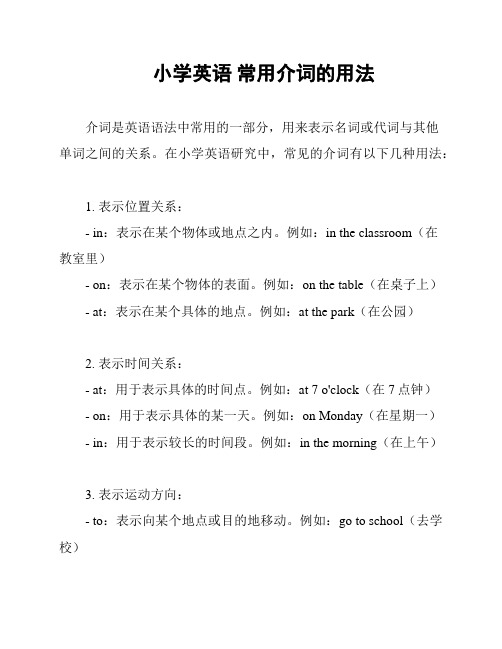
小学英语常用介词的用法介词是英语语法中常用的一部分,用来表示名词或代词与其他单词之间的关系。
在小学英语研究中,常见的介词有以下几种用法:1. 表示位置关系:- in:表示在某个物体或地点之内。
例如:in the classroom(在教室里)- on:表示在某个物体的表面。
例如:on the table(在桌子上)- at:表示在某个具体的地点。
例如:at the park(在公园)2. 表示时间关系:- at:用于表示具体的时间点。
例如:at 7 o'clock(在7点钟)- on:用于表示具体的某一天。
例如:on Monday(在星期一)- in:用于表示较长的时间段。
例如:in the morning(在上午)3. 表示运动方向:- to:表示向某个地点或目的地移动。
例如:go to school(去学校)- into:表示进入某个地点或物体之中。
例如:jump into the water(跳进水里)- out of:表示离开某个地点或物体之外。
例如:get out of the car(从车里出来)4. 表示原因、目的、方式等:- for:表示目的或原因。
例如:give a gift for his birthday(为他的生日送礼物)- with:表示伴随或使用工具。
例如:draw with a pencil(用铅笔画)- by:表示通过某种方式或方法。
例如:travel by train(乘火车旅行)以上介词的用法是小学英语中常见的,可以根据具体情境和需求进行运用。
在研究过程中,可以通过阅读和听力练来熟悉和掌握更多的介词用法。
注:以上内容为一般英语语法常识,具体的教学内容和要求可能根据学校和教材而有所差异,请参照教材和教师的指导进行学习。
小学英语课本介词表
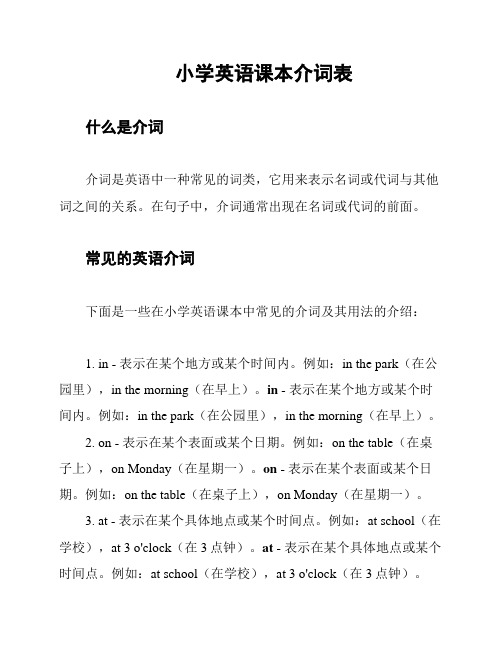
小学英语课本介词表什么是介词介词是英语中一种常见的词类,它用来表示名词或代词与其他词之间的关系。
在句子中,介词通常出现在名词或代词的前面。
常见的英语介词下面是一些在小学英语课本中常见的介词及其用法的介绍:1. in - 表示在某个地方或某个时间内。
例如:in the park(在公园里),in the morning(在早上)。
in - 表示在某个地方或某个时间内。
例如:in the park(在公园里),in the morning(在早上)。
2. on - 表示在某个表面或某个日期。
例如:on the table(在桌子上),on Monday(在星期一)。
on - 表示在某个表面或某个日期。
例如:on the table(在桌子上),on Monday(在星期一)。
3. at - 表示在某个具体地点或某个时间点。
例如:at school(在学校),at 3 o'clock(在3点钟)。
at - 表示在某个具体地点或某个时间点。
例如:at school(在学校),at 3 o'clock(在3点钟)。
4. under - 表示在某个物体的下面。
例如:under the table(在桌子下面)。
under - 表示在某个物体的下面。
例如:under the table (在桌子下面)。
5. above - 表示在某个物体的上面。
例如:above the sky(在天空上方)。
above - 表示在某个物体的上面。
例如:above the sky(在天空上方)。
6. beside - 表示在某物体的旁边。
例如:beside the lake(在湖边)。
beside - 表示在某物体的旁边。
例如:beside the lake(在湖边)。
7. between - 表示在两个物体或人之间。
例如:between the two trees(在两棵树之间)。
between - 表示在两个物体或人之间。
- 1、下载文档前请自行甄别文档内容的完整性,平台不提供额外的编辑、内容补充、找答案等附加服务。
- 2、"仅部分预览"的文档,不可在线预览部分如存在完整性等问题,可反馈申请退款(可完整预览的文档不适用该条件!)。
- 3、如文档侵犯您的权益,请联系客服反馈,我们会尽快为您处理(人工客服工作时间:9:00-18:30)。
小学英语介词用法1、小学英语介词at,in与on在时间方面的用法at表示时间的一点;in表示一个时期;on表示特殊日子。
如:He goes to school at seven o’clock in the morning. 他早晨七点上学。
Can you finish the work in two days. 你能在两天内完成这个工作吗?Linda was born on the second of May. 琳达五月二日出生。
1). at后常接几点几分,天明,中午,日出,日落,开始等。
如:at five o’clock (五点),at down (黎明),at daybreak (天亮),at sunrise (日出),at noon (中午),at sunset (日落),at midnight (半夜),at the beginning of the month (月初), at that time (那时),at that moment (那会儿),at this time of day (在一天的这个时候)。
2). in后常接年,月,日期,上午,下午,晚上,白天,季节,世纪等。
如:in 2006(2006年),in May,2004 (2004年五月),in the morning (早晨/上午),in the afternoon (下午),in the evening (晚上),in the night (夜晚),in the daytime (白天),in the 21st century (21世纪),in three days (weeks/month)三天(周/个月),in a week (一周),in spring (春季)。
3). on后常接某日,星期几,某日或某周日的朝夕,节日,及有修饰语修饰的下午、晚上等。
如:on Sunday (星期日),on a warm morning in April (四月的一个温暖的上午),on a December night (12月的一个夜晚),on that afternoon (那天下午),on the following night (下一个晚上),on Christmas afternoon (圣诞节下午),on October 1,1949 (1949年10月1日),on New Year’s Day (新年),on New Year’s Eve (除夕),on the morning of the 15th (15日的早上)等。
小学英语语法介词 for 的用法小结1. 表示"当作、作为"。
如:I like some bread and milk for breakfast. 我喜欢把面包和牛奶作为早餐。
What will we have for supper? 我们晚餐吃什么?2. 表示理由或原因,意为"因为、由于"。
如:Thank you for helping me with my English. 谢谢你帮我学习英语。
Thank you for your last letter. 谢谢你上次的来信。
Thank you for teaching us so well. 感谢你如此尽心地教我们。
3. 表示动作的对象或接受者,意为"给……"、"对…… (而言)"。
如:Let me pick it up for you. 让我为你捡起来。
Watching TV too much is bad for your health. 看电视太多有害于你的健康。
4. 表示时间、距离,意为"计、达"。
如:I usually do the running for an hour in the morning. 我早晨通常跑步一小时。
We will stay there for two days. 我们将在那里逗留两天。
5. 表示去向、目的,意为"向、往、取、买"等。
如:Let's go for a walk. 我们出去散步吧。
I came here for my schoolbag.我来这儿取书包。
I paid twenty yuan for the dictionary. 我花了20元买这本词典。
6. 表示所属关系或用途,意为"为、适于……的"。
如:It's time for school. 到上学的时间了。
Here is a letter for you. 这儿有你的一封信。
7. 表示"支持、赞成"。
如:Are you for this plan or against it? 你是支持还是反对这个计划?8. 用于一些固定搭配中。
如:Who are you waiting for? 你在等谁?For example, Mr Green is a kind teacher. 比如,格林先生是一位心地善良的老师。
小升初介词语法讲解地点介词in, at, on above, below, over, under, among, between的用法及区别(1)in, at与on的用法及区别①in表示地点,意为“在…内”,用于内部。
如:There isn’t a cloud in the sky. 天空中没有一片云。
He put his hands in his pockets. 他把手放入口袋。
What’s in the box? 盒子里有什么?②on意为“在…上面”,用于表面接触,指在一个平面上。
如:What’s on the table? 桌子上有什么?There was a carpet on the floor. 地板上铺着一块地毯。
③表示“在某地”时,at后面接小地方,in后接大地方。
如:at home在家 at the bus stop在汽车站 in China在中国 in the world 在世界上(2)above与below的用法及区别above的意思是“在…之上”“高于…”,表示相对高度,不一定是在正上方,它的反义词是below。
如:The plane flew above the clouds. 飞机在云层上面飞行。
The Dead Sea is below sea level. 死海的海面低于海平面。
(3)over与under的用法及区别over的意思是“在…之上”,表示垂直之上,其反义词是under。
如:There is a bridge over the river. 河上有座桥。
There is a boat under the bridge. 桥下有只船。
(4)among与between的用法及区别between一般指“两者之间”。
among用于三个或三个以上的人或物之间,或笼统的一群人或一些物之中。
如:The house stands between two farms. 这座房子位于两个农场之间。
The house stands among farms. 这座房子位于农场之间。
(5)beside与near的用法及区别(本部分只出现在教师版中)①beside表示“近旁”“紧靠”,相当于next to。
如:Come and sit beside me. 来坐在我的身旁。
②near意为“在…附近”,可以表示空间、时间关系等。
如:He sits near the window. 他坐在窗户附近。
(6)in front of与in the front of的用法及区别(本部分只出现在教师版中)in front of表示“在…之前”。
表示在某一空间外部的前面,in the front of 表示在某一空间内部的前面。
如:There are some trees in front of the classroom. 教室前有一些树。
Don’t sit in the front of the car. 不要坐在小汽车的前部。
3)方式介词like像… with用… in用… by用…方式介词:with, by, in的用法及区别with, by, in表示工具、手段和材料时,with多指用工具,用身体的某一部位或器官;by表示使用的方法、手段;in指使用某种语言、工具的具体类型等。
如:You can see it with your own eyes. 你可以亲自去看看。
Why don’t we go there by car instead? 我们为什么不坐小汽车去呢?She can speak it in English. 她能用英语说。
4)其他含义的介词of具有…的性质 with带有… without没有… instead of而不是… except 除了…beside包括…在内1.表示地点位置的介词in, on, to,forat (1)表示在小地方; (2)表示“在……附近,旁边”in (1)表示在大地方; (2)表示“在…范围之内”。
on 表示在……上面”。
to 表示或“到……”under 在……下面in the front of在……前面behind(在……的后面)。
There are some flowers in front of the house.(房子前面有些花卉。
) beside 表示在……旁边behind 表示在……后面2.表示时间的介词1)in , on,at 在……时in表示较长时间,如世纪、朝代、时代、年、季节、月及一般(非特指)的早、中、晚等。
如 in the 20th century, in the 1950s, in 1989, in summer, in January, in the morning, in one’s life , in one’s thirties等。
on表示具体某一天及其早、中、晚。
如on May 1st, on Monday, on New Year’s Day, on a cold night i n January, on a fine morning, on Sunday afternoon等。
at表示某一时刻或较短暂的时间,或泛指圣诞节,复活节等。
如at 3:20, at this time of year, at the beginning of, at the end of …, at the age of …, at Christmas, at night, at noon, at this moment等。
